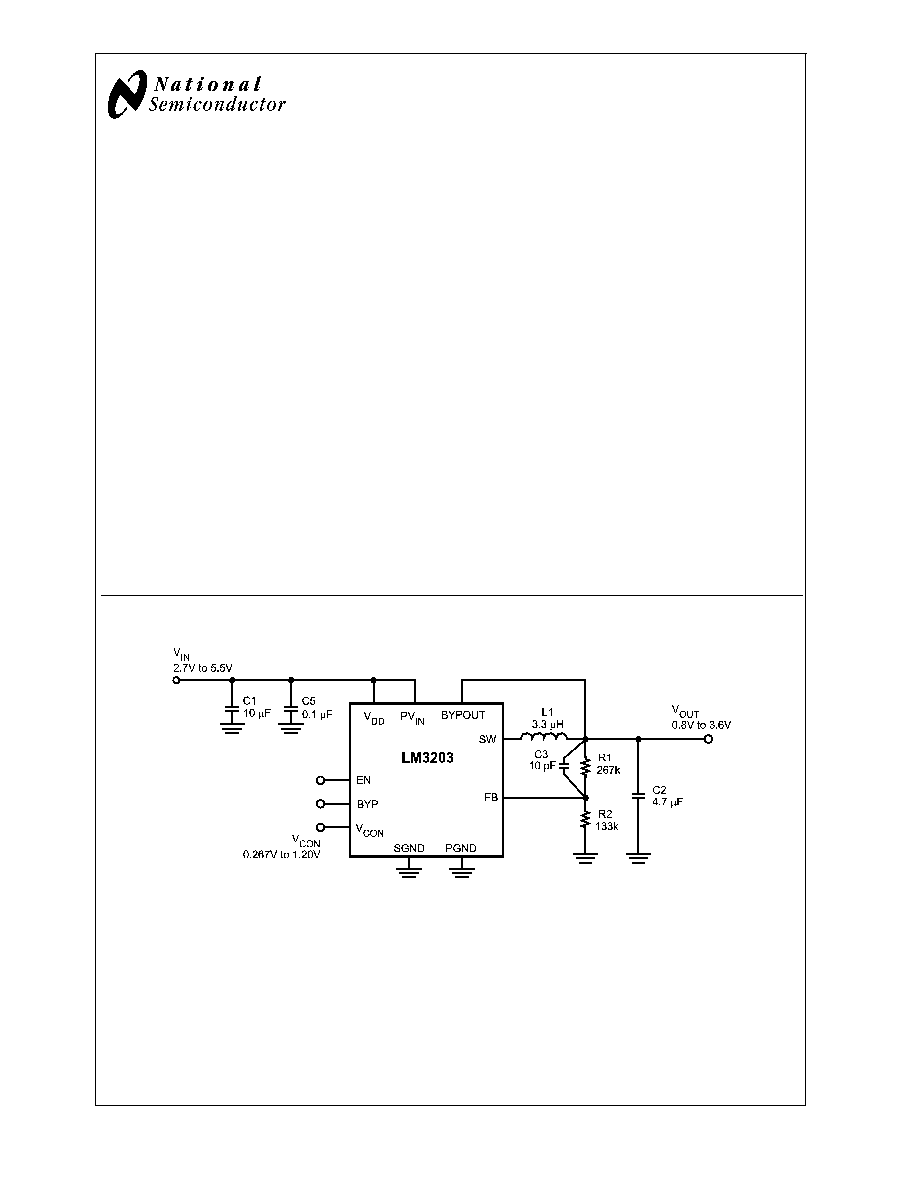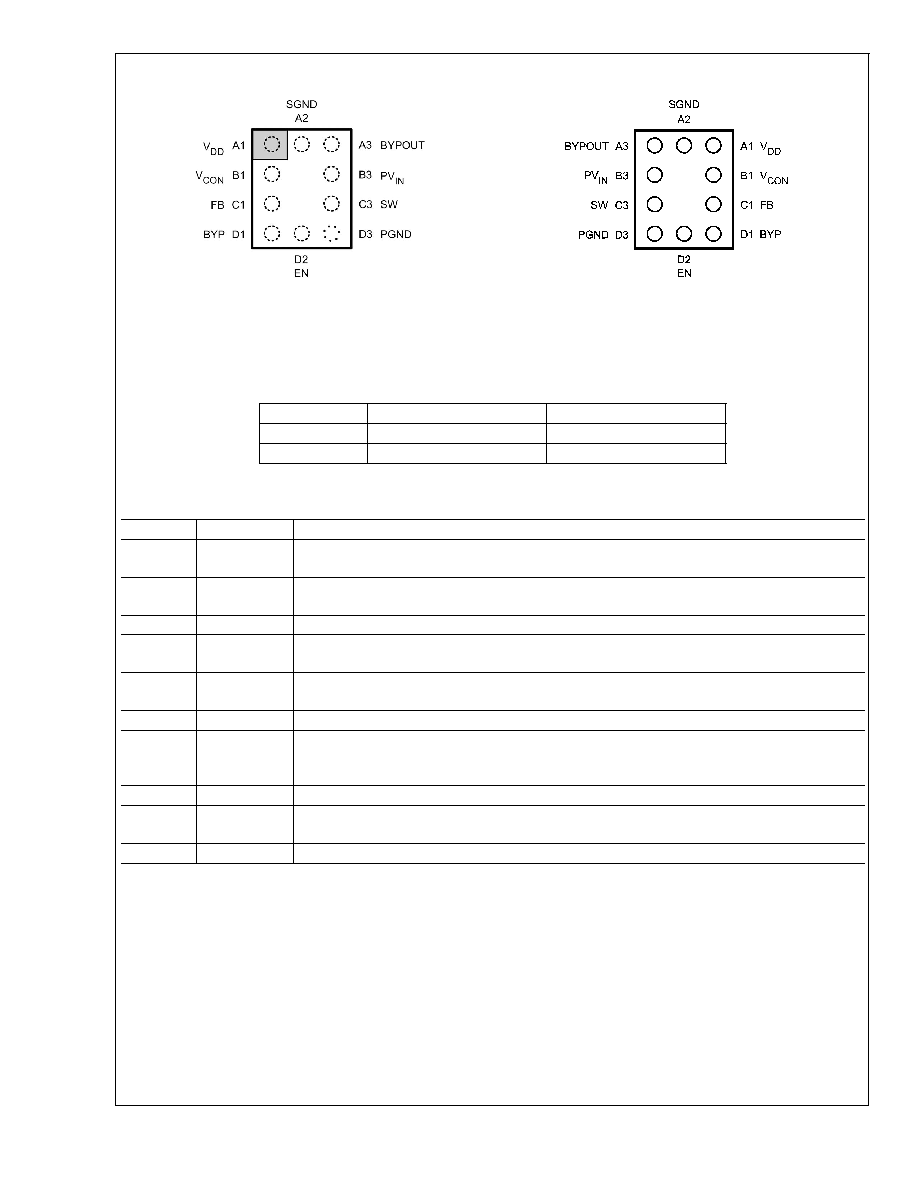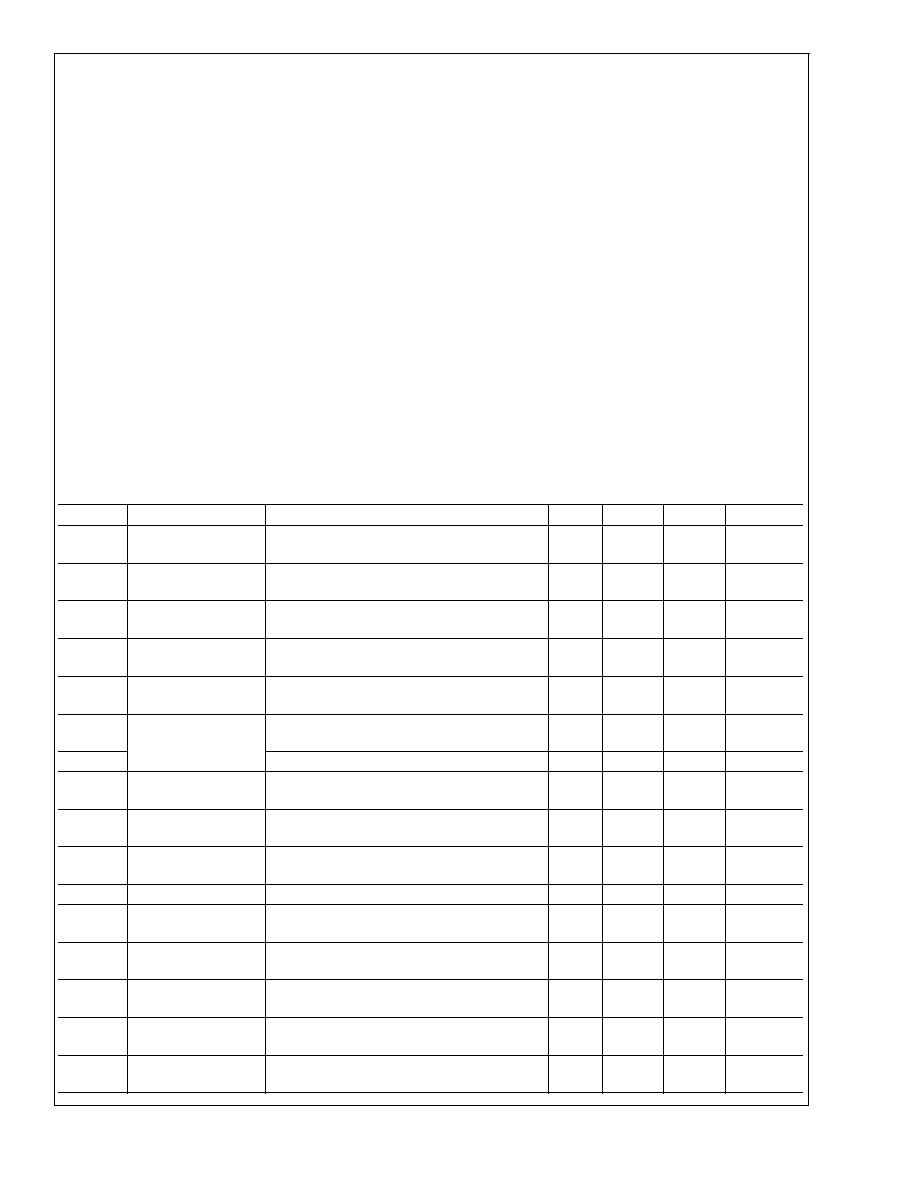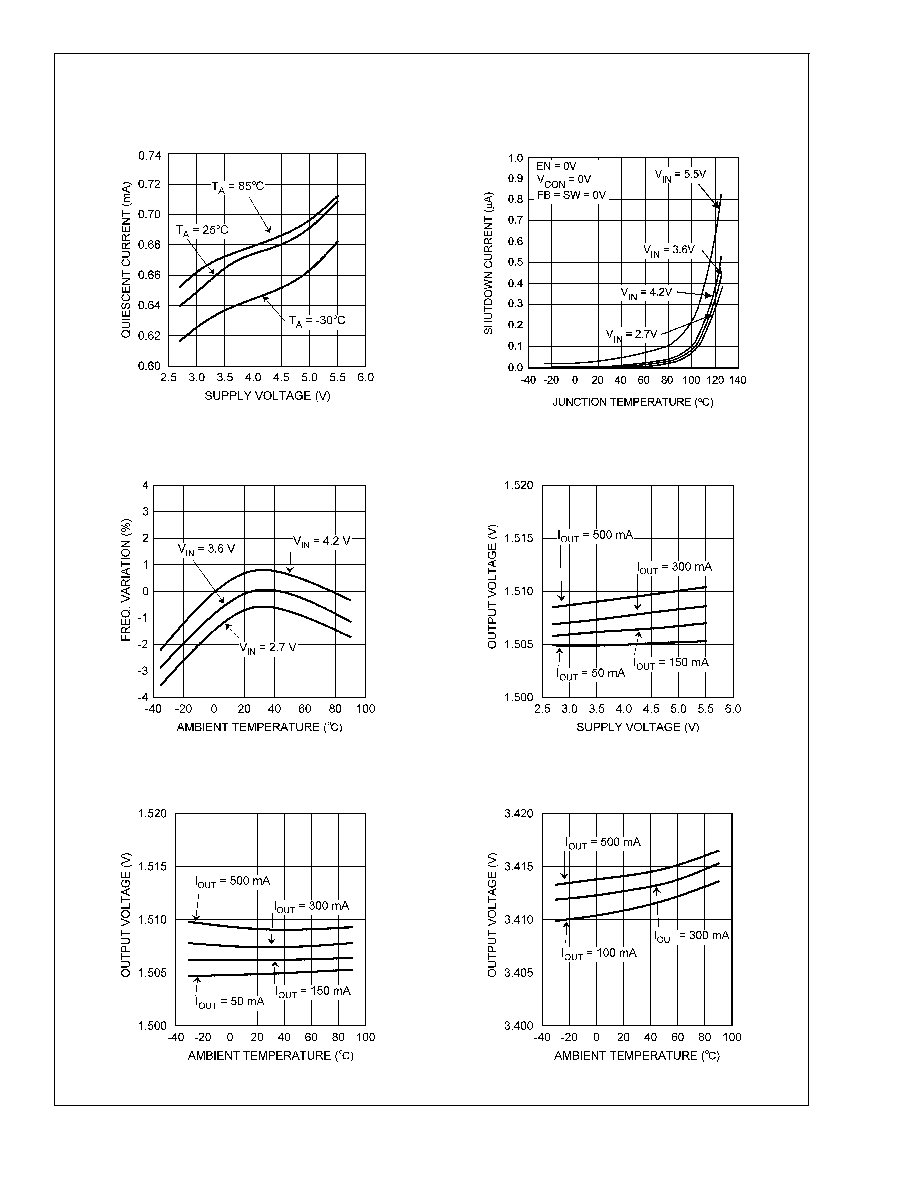 | –≠–ª–µ–∫—Ç—Ä–æ–Ω–Ω—ã–π –∫–æ–º–ø–æ–Ω–µ–Ω—Ç: LM3203TL | –°–∫–∞—á–∞—Ç—å:  PDF PDF  ZIP ZIP |

LM3203
Step-Down DC-DC Converter with Bypass Mode for
CDMA / WCDMA RF Power Amplifiers
General Description
The LM3203 is a DC-DC converter optimized for powering
RF power amplifiers (PAs) from a single Lithium-Ion cell.
However, they may be used in many other applications. It
steps down an input voltage of 2.7V to 5.5V to an adjustable
output voltage of 0.8V to 3.6V. The output voltage is set
using a V
CON
analog input and external resistor dividers for
optimizing efficiency of the RF PA at various power levels.
The LM3203 offers 3 modes for mobile phones and similar
RF PA applications. Fixed-frequency PWM mode minimizes
RF interference. Bypass mode turns on an internal bypass
switch to power the PA directly from the battery. Shutdown
mode turns the device off and reduces battery consumption
to 0.1µA (typ.).
The LM3203 is available in a 10-pin lead free micro SMD
package. A high switching frequency (2MHz) allows use of
tiny surface-mount components.
Features
n
2MHz (typ.) PWM Switching Frequency
n
Operates from a single Li-Ion cell (2.7V to 5.5V)
n
Adjustable Output Voltage (0.8V to 3.6V)
n
500mA Maximum load capability (PWM and Bypass
mode)
n
PWM / Forced Bypass Mode
n
Low R
DSON
Bypass FET: 85m
(typ.)
n
High Efficiency (96% typ. at 3.6V
IN
, 3.2V
OUT
at 150mA)
n
Fast Turn-on time when Enabled (50µs typ.), 3GPP
Compliant
n
10-pin micro SMD Package
n
Current Overload Protection
n
Thermal Overload Protection
Applications
n
Cellular Phones
n
Hand-Held Radios
n
RF PC Cards
n
Battery Powered RF Devices
Typical Application
20141601
July 2005
LM3203
Step-Down
DC-DC
Converter
with
Bypass
Mode
for
CDMA
/
WCDMA
RF
Power
Amplifiers
© 2005 National Semiconductor Corporation
DS201416
www.national.com

Connection Diagrams
20141602
Top View
20141603
Bottom View
10≠Bump Thin Micro SMD Package, Large Bump
See NS Package Number TLP10NHA
Order Information
Order Number
Package Marking (Note)
Supplied As
LM3203TL
XYTT SFYB
250 Units, Tape and Reel
LM3203TLX
XYTT SFYB
3000 Units, Tape and Reel
Note: The package marking "XY" designates the date code. "TT" is a NSC internal code for die traceability.
Pin Description
Pin #
Name
Description
A1
V
DD
Analog Supply Input. A 0.1 µF ceramic capacitor is recommended to be placed as close to this
pin as possible. (Figure 1)
B1
V
CON
Voltage Control Analog input. V
CON
controls V
OUT
in PWM mode. (Refer Setting the output
voltage under Application information.) Do not leave floating.
C1
FB
Feedback Analog Input. Connect to the external resistor divider. (Figure 1)
D1
BYP
Bypass. Use this digital input to command operation in Bypass mode. Set BYP low for PWM
operation.
D2
EN
Enable Input. Set this digital input high after Vin
>
2.7V for normal operation. For shutdown, set
low.
D3
PGND
Power Ground
C3
SW
Switching Node connection to the internal PFET switch and NFET synchronous rectifier.
Connect to an inductor with a saturation current rating that exceeds the maximum Switch Peak
Current Limit specification of the LM3203.
B3
PV
IN
Power Supply Voltage Input to the internal PFET switch and Bypass FET. (Figure 1)
A3
BYPOUT
Bypass FET Drain. Connect to the output capacitor. (Figure 1) Connect this pin to V
DD
when
Bypass mode is NOT required. Do not leave floating.
A2
SGND
Analog and Control Ground
LM3203
www.national.com
2

Absolute Maximum Ratings
(Notes 1, 2)
If Military/Aerospace specified devices are required,
please contact the National Semiconductor Sales Office/
Distributors for availability and specifications.
V
DD
, PV
IN
to SGND
-0.2V to +6.0V
PGND to SGND
-0.2V to +0.2V
EN, FB, BYP, V
CON
(SGND -0.2V)
to (V
DD
+0.2V)
w/6.0V max
SW, BYPOUT
(PGND -0.2V)
to (PV
IN
+0.2V)
w/6.0V max
PV
IN
to V
DD
-0.2V to +0.2V
Continuous Power Dissipation
(Note 3)
Internally Limited
Junction Temperature (T
J-MAX
)
+150∞C
Storage Temperature Range
-65∞C to +150∞C
Maximum Lead Temperature
(Soldering, 10 sec)
+260∞C
ESD Rating (Note 4)
Human Body Model
2.0 kV
Operating Ratings
(Notes 1, 2)
Input Voltage Range
2.7V to 5.5V
Recommended Load Current
PWM Mode
0mA to 500mA
Bypass Mode
0mA to 500mA
Junction Temperature (T
J
) Range
-30∞C to +125∞C
Ambient Temperature (T
A
) Range
(Note 5)
-30∞C to +85∞C
Thermal Properties
Junction-to-Ambient Thermal
100∞C/W
Resistance (
JA
), TLP10 Package (Note 6)
Electrical Characteristics
(Notes 2, 7) Limits in standard typeface are for T
A
= T
J
= 25∞C. Limits in bold-
face type apply over the full operating ambient temperature range (-30∞C
T
A
= T
J
+85∞C). Unless otherwise noted, speci-
fications apply to the LM3203 with: PV
IN
= V
DD
= EN = 3.6V, BYP = 0V, V
CON
= 0.267V.
Symbol
Parameter
Conditions
Min
Typ
Max
Units
V
IN
Input Voltage Range
(Note 8)
PV
IN
= V
DD
= V
IN
2.7
5.5
V
V
FB, MIN
Feedback Voltage at
Minimum Setting
V
CON
= 0.267V, V
IN
= 3.6V
0.250
0.267
0.284
V
V
FB, MAX
Feedback Voltage at
Maximum Setting
V
CON
= 1.20V, V
IN
= 4.2V
1.176
1.200
1.224
V
OVP
Over-Voltage
Protection Threshold
(Note 9)
100
150
mV
I
SHDN
Shutdown Supply
Current (Note 10)
EN = SW = BYPOUT = V
CON
= FB = 0V
0.1
3
µA
I
Q_PWM
DC Bias Current into
V
DD
V
CON
= 0.267V, FB = 2V, BYPOUT = 0V, No
Switching
675
780
µA
I
Q_BYP
BYP = 3.6V, V
CON
= 0.5V, No Load
680
780
µA
R
DSON (P)
Pin-Pin Resistance for
P-FET
I
SW
= 500mA
320
450
m
R
DSON (N)
Pin-Pin Resistance for
N-FET
I
SW
= - 200mA
310
450
m
R
DSON
(BYP)
Pin-Pin Resistance for
Bypass FET
I
BYPOUT
= 500mA
85
120
m
I
LIM-PFET
Switch Current Limit
(Note 11)
700
820
940
mA
I
LIM-BYP
Bypass FET Current
Limit
(Note 12)
800
1000
1200
mA
F
OSC
Internal Oscillator
Frequency
1.7
2
2.2
MHz
V
IH
Logic High Input
Threshold for EN, BYP
1.20
V
V
IL
Logic Low Input
Threshold for EN, BYP
0.4
V
I
PIN
Pin Pull Down Current
for EN, BYP
EN, BYP = 3.6V
5
10
µA
LM3203
www.national.com
3

Electrical Characteristics
(Notes 2, 7) Limits in standard typeface are for T
A
= T
J
= 25∞C. Limits in boldface
type apply over the full operating ambient temperature range (-30∞C
T
A
= T
J
+85∞C). Unless otherwise noted,
specifications apply to the LM3203 with: PV
IN
= V
DD
= EN = 3.6V, BYP = 0V, V
CON
= 0.267V. (Continued)
Symbol
Parameter
Conditions
Min
Typ
Max
Units
Gain
V
CON
to V
OUT
Gain
1
V/V
Z
CON
V
CON
Input Resistance V
CON
= 1.2V
1
M
System Characteristics
The following spec table entries are guaranteed by design over ambient temperature
range if the component values in the typical application circuit are used. These parameters are not guaranteed by produc-
tion testing.
Symbol
Parameter
Conditions
Min
Typ
Max
Units
T
STARTUP
Time for V
OUT
to rise
to 3.4V in PWM mode
V
IN
= 4.2V, C
OUT
= 4.7µF,
R
LOAD
= 10
L = 3.3uH (I
SAT
>
0.94A)
EN = Low to High
50
µs
T
RESPONSE
Time for V
OUT
to Rise
from 0.8V to 3.6V in
PWM Mode
V
IN
= 4.2V, C
OUT
= 4.7µF,
R
LOAD
= 10
L = 3.3uH (I
SAT
>
0.94A)
30
µs
C
CON
V
CON
Input
Capacitance
V
CON
= 1V,
Test frequency = 100kHz
15
pF
T
ON_BYP
Bypass FET Turn On
Time In Bypass Mode
V
IN
= 3.6V, V
CON
= 0.267V,
C
OUT
= 4.7µF, R
LOAD
= 10
BYP = Low to High
30
µs
Note 1: Absolute Maximum Ratings indicate limits beyond which damage to the component may occur. Operating Ratings are conditions under which operation of
the device is guaranteed. Operating Ratings do not imply guaranteed performance limits. For guaranteed performance limits and associated test conditions, see the
Electrical Characteristics tables.
Note 2: All voltages are with respect to the potential at the GND pins.
Note 3: Internal thermal shutdown circuitry protects the device from permanent damage. Thermal shutdown engages at T
J
= 150∞C (typ.) and disengages at T
J
=
130∞C (typ.).
Note 4: The Human body model is a 100pF capacitor discharged through a 1.5k
resistor into each pin. (MIL-STD-883 3015.7) . National Semiconductor
recommends that all integrated circuits be handled with appropriate precautions.
Note 5: In applications where high power dissipation and/or poor package thermal resistance is present, the maximum ambient temperature may have to be
de-rated. Maximum ambient temperature (T
A-MAX
) is dependent on the maximum operating junction temperature (T
J-MAX-OP
= 125∞C), the maximum power
dissipation of the device in the application (P
D-MAX
), and the junction-to ambient thermal resistance of the part/package in the application (
JA
), as given by the
following equation: T
A-MAX
= T
J-MAX-OP
≠ (
JA
x P
D-MAX
).
Note 6: Junction-to-ambient thermal resistance (
JA
) is taken from thermal measurements, performed under the conditions and guidelines set forth in the JEDEC
standard JESD51-2. A 1" x 1", 4 layer, 1.5oz. Cu board was used for the measurements.
Note 7: Min and Max limits are guaranteed by design, test, or statistical analysis. Typical numbers are not guaranteed, but do represent the most likely norm.
Note 8: The LM3203 is designed for mobile phone applications where turn-on after power-up is controlled by the system controller and where requirements for a
small package size overrule increased die size for internal Under Voltage Lock-Out (UVLO) circuitry. Thus, it should be kept in shutdown by holding the EN pin low
until the input voltage exceeds 2.7V.
Note 9: Over-Voltage protection (OVP) threshold is the voltage above the nominal V
OUT
where the OVP comparator turns off the PFET switch while in PWM mode.
The OVP threshold will be the value of the threshold at the FB voltage times the resistor divider ratio. In the Figure 1, 100mV (typ.) x ((267K + 133K) ˜ 133K).
Note 10: Shutdown current includes leakage current of PFET and Bypass FET.
Note 11: Electrical Characteristic table reflects open loop data (FB=0V and current drawn from SW pin ramped up until cycle by cycle current limit is activated).
Refer to datasheet curves for closed loop data and its variation with regards to supply voltage and temperature. Closed loop current limit is the peak inductor current
measured in the application circuit by increasing output current until output voltage drops by 10%.
Note 12: Bypass FET current limit is defined as the load current at which the FB voltage is 1V lower than V
IN
.
LM3203
www.national.com
4

Typical Performance Characteristics
(Circuit in Figure 1, PV
IN
= V
DD
= EN = 3.6V, BYP = 0V, T
A
=
25∞C, unless otherwise noted)
Quiescent Current vs Supply Voltage
(V
CON
= 0.267V, FB = 2V, No Load)
Shutdown Current vs Temperature
(EN = 0V)
20141604
20141605
Switching Frequency Variation vs Temperature
(V
OUT
= 1.5V, I
OUT
= 200 mA)
Output Voltage vs Supply Voltage
(V
OUT
= 1.5V, V
CON
= 0.5V)
20141606
20141607
Output Voltage vs Temperature
(V
IN
= 3.6V, V
OUT
= 1.5V, V
CON
= 0.5V)
Output Voltage vs Temperature
(V
IN
= 4.2V, V
OUT
= 3.4V, V
CON
= 1.13V)
20141608
20141609
LM3203
www.national.com
5




